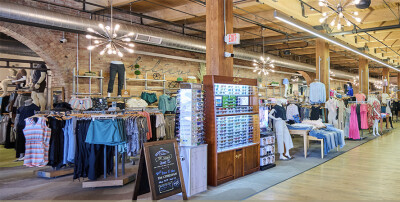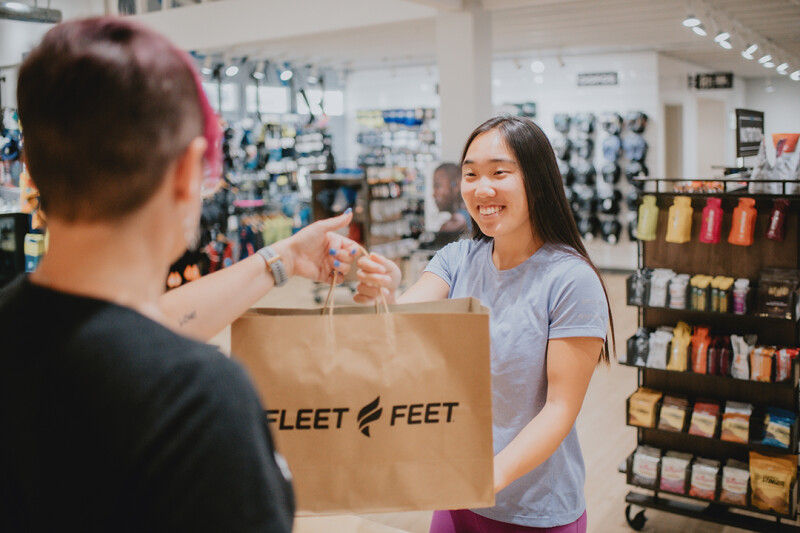One of the top 10 education sessions at The Running Event 2024 in Austin, TX, was “Apparel in Run Specialty: Lessons Learned from 30 Years.” The session featured insights from Daniel Greenhalgh and Tasha Heikkila-Adam, owners of Skinny Raven, and Adam White, owner of RC Outfitters. The goal: To convince their fellow run specialty retailers to make the effort and invest the resources in product and training to sell apparel in their stores. What follows is a synopsis of their message and words of advice on, as they put it in their presentation, how apparel can make you a ****load of money.
Why should you sell running apparel? Perhaps it is best to recognize the difference in why your customers come to your store for different products.
They BUY running. Specialty running purchases are most often driven by need. We wear out our shoes. Our shins hurt, our knees hurt, our feet hurt. We get holes in our socks. We blow out elastic bands in our favorite running shorts. We need replacements.
They SHOP apparel. Apparel shopping is most often driven by wants and desires. We seek out cool apparel. It makes us feel good. Retail therapy is real. We want to see what’s new. We want to shop apparel for ourselves and for gifts.
Implementing the fundamental ingredients will set you up for success. Follow the recipe. Have patience. Pay attention. It will pay off. Here’s how to do it.
1. Take It Seriously.
Dedicate time and attention to your apparel department. Success in this investment is a marathon, not a sprint.
2. Invest in Your Infrastructure.
This includes your dressing rooms, apparel fixtures and visual merchandising. Quality apparel boutiques create the feelings and emotions that attract customers and resonate so they will return. You are competing with the best apparel boutiques in your community, so you need to look the part.
3. Allocate and Curate.
Curate a meaningful assortment that is relevant to your community and your market. Allocate apparel seamlessly to the space you have available for an impactful experience.
Tailor your apparel offerings based on store size and location, available space, customer needs and seasonality. Focus on core and year-round items, then add limited-edition styles seasonally. Some curating considerations:
• Consider your community, weather, store size and proximity to competitors when curating apparel.
• Branded apparel and accessories can be top sellers with good margins and easy minimums.
• If your store is less than 1500-square feet, focus on branded apparel, accessories and small lifestyle items. At about 2500-square feet you can bring in expanded branded apparel and accessories, small runs of core running brands and seasonal crossovers. Larger stores (more than 2500-square feet) can offer a branded focus, more lifestyle, SIS options, more seasonal/colors to core brands and an elevated dressing room experience.
4. Always nurture your apparel department … regardless of store size.
• Assign dedicated team member(s) to watch and study the department so they can fill in when needed and dump when necessary. They need to watch your apparel department like you watch your footwear.
• Never run out of key sizes.
• If something isn’t selling, identify it and cut your losses, then replace it with something that is going to turn and make you money. Your real estate is too valuable to let it become stagnant.
Follow The Apparel Recipe
A successful apparel department will look different for every retailer, but the fundamental ingredients for success are the same. You need to make it work for your business, your team, your store and your community.
When it comes to selling apparel, common fears abound in run specialty. Is apparel too much work? Is there enough return? Take it from us, proven opportunities do exist. Follow this recipe to begin with:
• 70 percent shoe sales, 30 percent accessories, nutrition and apparel.
• 60-70 percent of apparel should be core (black shorts, tights, tees)
• 30 percent of apparel should be fun, seasonal, unexpected items.
Where to begin? Focus on core apparel, then add seasonal/fun items at smaller price points to inspire customers, to enhance apparel shopping and for gift-giving. Ten percent apparel sales at your store is achievable with the right approach. Get over the fear.
Apparel attracts new customers, enhances your community and expands both your brand and the customer experience. An apparel department can undoubtedly strengthen your store, regardless of size, and you can see profit even when you start small.
Here are more reasons why apparel matters:
• Community Engagement and Growth. Apparel boosts customer loyalty and repeat business. Seasonal products attract additional customer visits with timely needs.
• Vendor Partnerships. Co-marketing and exclusive collaborations with vendors accelerate apparel sales.
• Extension of your Brand. Apparel extends your brand’s scope and experiences beyond running. Expanding your offerings strengthens your community with more resources and solutions.
Utilizing Events and Activations
Events can bring apparel to the forefront with a sense of exclusivity, while activations offer focused marketing plus calls to action. Use events to showcase apparel and engage customers.
• Activate Meaningful Campaigns with Vendors. Use demos to feature both shoes and apparel. Activate cross-promotional marketing with vendors to drive sales.
• Local Events Equal Community. Host spike days with the additions of fun socks, accessories and apparel. Feature staff favorites in-store and on social media. Activate race day displays to position yourself in front of ideal customers. Host/participate in fashion shows and fundraisers. Host fitting events (public or private) for specific groups, teams, or activities.
The Merchandising Angle
Merchandising should be tidy, fresh and visually engaging. Focus on merchandising that makes apparel easy to browse and fun. Put yourself in the shoes of the shopper.
To achieve that, communicate the value of selling apparel to your team and train them accordingly. Make sure they are aware that when shopping for apparel the customer experience is everything.
• Educate Your Staff. Core product knowledge (e.g., water resistance, pockets) creates excitement. Knowledgeable staff who believe in the products and care about the customer are invaluable.
• Keep It Fresh. Move products every one-to-two weeks to keep displays fresh. At 45 days on floor, pull the product (RMA or sale). Style mannequins thoughtfully with accessories.
• Create Shoppable Displays. Ensure displays make sense — line of sight is key. Add interest with creative tables and shelves.
The Importance of Buying Right
Smart buying focuses on curating, testing and balancing core and seasonal items. Minimize risk and maximize impact. No in-season restocking for seasonal items — sell out. Here are some smart buying practices.
• Try Something New. Test products for one or two seasons. If they don’t sell, cut them.
• Accessories = Low-Risk. Accessories take up less space and have good margins. Water bottles, hats, headbands and stickers are great options.
• Small Runs = Curated Selection. Small runs allow for a curated assortment based on customer demand. Focus on core items, but test seasonal/fun styles.
• Balance Run/Active with Lifestyle. It is important to serve your core customer but also offer them something a little bit different.
Some Key Takeaways
Apparel can be simple for run specialty retailers. You just need to balance branded products, core, seasonal, accessories and fun. Focus on curating for your market and creating a unique, engaging shopping experience.
• Offer the items customers expect to find, then add products that surprise and delight. Curation is key. Space determines the quantity, not the selection.
• Use vendor co-marketing to partner on exclusive products, shared events, and promotion.
• Design tidy, fresh, fun, shoppable displays.
• Run specialty is known for exceptional service. Apply this to apparel.







